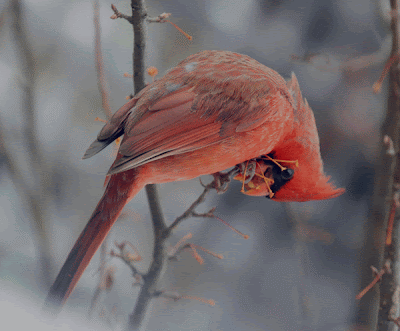 Photo courtesy of Kelly Riccetti at Red and the Peanut
Photo courtesy of Kelly Riccetti at Red and the Peanut
Continuing our series on “Surviving the Winter by Staying Connected to Nature,” today’s post is about enjoying nature from inside, and in particular, feeding and watching the birds.
It’s true that one of the keys to making it through the winter is getting outside (more on that in the next post). But let’s face it: Even if we do venture forth, we’re probably not going to be out very long. So what is a “healing garden” in winter? One that we can gaze upon and enjoy from indoors. And what better way to hold our attention than watching the birds? It’s certainly been keeping me going this winter. This is the first year that I’ve noticed white-breasted nuthatches flitting back and forth from the bird feeder to the white oak. And in addition to the usual sparrows, crows, dark-eyed juncos, starlings, and cardinals, we seem to have more chickadees and tufted titmice (titmouses?) this year as well. Such a delight!
I want to especially encourage nurses, administrators, volunteers and family members who care for seniors to do more to attract birds. Place bird feeders and baths (you can even buy heated ones) outside of private and community windows. Watching, identifying, and counting birds can bring a great deal of meaning (and social interaction) into people’s lives. Bird-watching is an excellent antidote to the common problems of boredom, loneliness, and isolation.
No matter what your age, here are some resources to get you started. There are two primary ways to attract birds to the garden. First, plant things that birds are attracted to for food and habitat. The following books and websites will help you choose what to plant and how to keep a garden that’s bird-friendly throughout the year:
- A nice article about How to Grow Your Own Bird Seed in the Garden.
- You can even plant specific things to attract specific birds. For example, goldfinches are drawn to Echinacea (purple coneflower), black-eyed Susans, Zinnias, sunflowers, and especially thistle – not only for the food but for the downy fibers used to line their nests (thanks to my new favorite blog Red and the Peanut for this info). Another example: Bluebirds loooove winterberry (Ilex verticillata).
- National Audubon Society’s book The Bird Garden: A Comprehensive Guide to Attracting Birds to Your Backyard Throughout the Year.
- National Wildlife Federation’s book Attracting Birds, Butterflies & Backyard Wildlife and also their Garden for Wildlife page.
- Rodale Organic Gardening’s Attracting Birds to Your Backyard.
- Cornell Lab of Ornithology’s All About Birds page.
- Brooklyn Botanic Garden’s book The Wildlife Gardener’s Guide, and their website Inviting Wildlife Into Your Winter Garden.
- The U.K.’s Wildlife Gardener.
- On the “macro” level, think about attracting not just the birds, but the critters that attract the birds. Insects, in general, provide a lot more nutrition than seed. Doug Tallamy’s Bringing Nature Home: How You Can Sustain Wildlife with Native Plants explains how this works and why we should care.
- Here are some of Tallamy’s top recommendations of both woody and herbaceous plants that support the butterflies and moths that feed the birds and keep our ecosystem healthy.
- I also highly recommend Bill Cullina’s list of Biodiversity All-Stars – the plants that support more than one species at a time – on the New England Wild Flower Society website. His list of top ten includes oak, crabapple, serviceberry, and red cedar.
- And finally, Carole Brown’s Choosing the Best Plants for Your Ecosystem Garden. Ecosystem Garden is a garden that supports the entire ecosystem, sustainably, rather than just us, or one type of animal or crop. You can read the full explanation here.
Second to providing natural food and habitat in your garden, supplement with birdfeeders and bird baths. The National Bird-Feeding Society is a great place to start. Learn about bird feed and feeder preference; how to prevent disease at bird feeders; best backyard bird-feeding practices, and more. And many of the websites listed above also provide information about this aspect of backyard bird-care as well.
All of these resources, plus a few more, are on the Therapeutic Landscapes Network’s Sensory & Wildlife Plants page. Stop on by, and if you have other recommendations, let us know.










